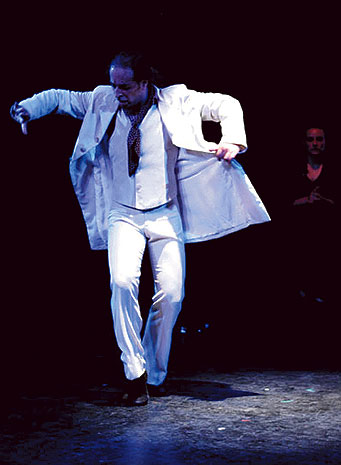In 2009 there was no Festival Flamenco Internacional. It was a sad year for the National Institute of Flamenco, which produces the showcase, and the hundreds of artists and fans who participate annually. The founder and artistic director of the fest, Eva Encinias Sandoval, says the decision to hold back was difficult. “We rely so much on students and aficionados coming from all over the country, actually all over the world, to see the festival,” she says. “In 2009 we knew the economy was such that there was a good likelihood that people would not be able to travel, to do something like this.” Sandoval and her colleagues chose to postpone the festival that year. But they were also determined to bring it back full force. Reshaping Festival Flamenco was a priority during the off-year, and Sandoval says there was no compromising the quality. Some of the advice she received was, “Maybe you should bring artists that are not quite of this caliber,” she says, to invite dancers “that are a little less expensive and try to cut your cost in that way.” But, Sandoval says, “we really weren’t willing to do that.” Instead they made other allowances, like decreasing the length from eight days to five. “If we were going to continue to do the festival, we were going to continue to bring these world-class artists.”The 2010 Festival Flamenco was successful in maintaining a high standard, and Sandoval says the 2011 version will continue in the same vein. Jose Maya and his company, who hail from Madrid, Spain, are some of this year’s guests. Sandoval says that Maya is an icon. “Flamenco artists are on a real high level of notoriety there, in Spain, so these artists that are coming are young, but very, very renowned … he’s like a rock star.” Another rock star of flamenco is María José Franco from Cádiz, Spain. She’s toured and garnered acclaim all over the world and, along with her company, will be featured at Festival Flamenco 2011. The young dancer Fuensanta la Moneta, who has won awards at international festivals, is another guest artist this year and is traveling from Granada. In fact, all the guest artists are from Spain, but Sandoval says that doesn’t decrease their diversity.“Madrid’s flamenco is stylistically different from the flamenco that comes out of Granada, which is different from the flamenco that comes from Sevilla,” she says. There’s a stereotype of what flamenco is, she adds, but it doesn’t come close to approaching contemporary flamenco—that which is being produced today, or hoy en día .Even within a company, styles vary. José Maya has three female dancers in his, Sandoval says, and each has her own take on the art form. “In flamenco, the whole point is to be as diverse as you possibly can.”That doesn’t stem from lackadaisical training. Flamenco starts with a very strict musical structure and careful technique, which are universal to the form. An artist works on getting fluent in the basics and then spends a lifetime developing his or her own voice. Although Sandoval herself is something of a rock star, having danced and performed her whole life, she is excited to be in the audience during the guest companies’ shows. “When I look at these young artists performing today, I’m just completely blown away by their facility,” she says. “That balance between technique and artistry—I’m in awe of what they have been able to develop.”There’s also a flourish of workshops that happens in Festival Flamenco. Classes begin with the very basics of the art form, and flare up into sessions in advanced dance technique, castanets, guitar and more. Fired-up folks can contact the National Institute of Flamenco, even after the festival has begun, to register.Sandoval says that Flamenco bridges demographics—that during a performance, no one is bored; everyone is intensely engaged. “You may not know what they’re singing about,” she says. “You may not know and understand the techniques involved, and the rigor involved in creating it. But you know that what you’re seeing is profound.”
Festival Flamenco InternacionalWednesday, June 8, through Sunday, June 12Events and classes take place at the National Hispanic Cultural Center and UNM’s Rodey Theater. Ticket and workshop prices vary. For a full listing of times, locales and prices, see ffinm.org or call 242-7600.












